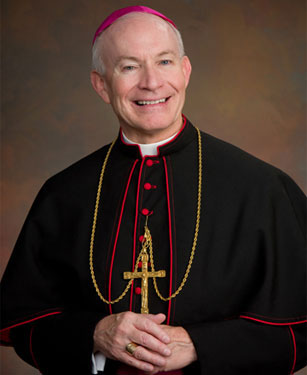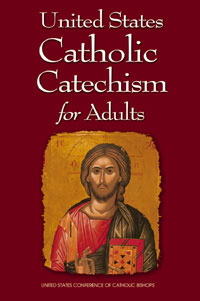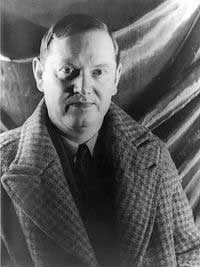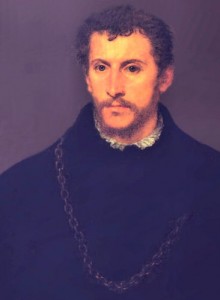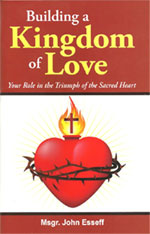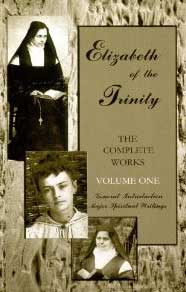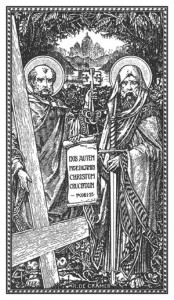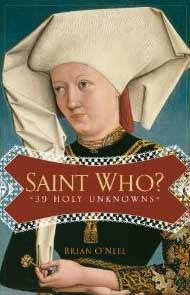USCCA16- Episode 16- Confirmation:Â Consecrated for Mission
[powerpress]
Archbishop Lucas offers insights on the US Catholic Catechism for Adults Chapter 16:
“When we are responsive to the grace of Confirmation and the seven gifts of the Holy Spirit, we begin to bear the fruits of the Spirit.  The tradition of the Church names twelve frutis of the Holy Spirit:  love, joy, peace, patience, kindness, goodness, generosity, gentleness, faithfulness, modesty, self-control, and chastity”
The Most Reverend George J. Lucas leads the Archdiocese of Omaha.Â
For other episodes in the visit our Archbishop George Lucas page
This programs is based on:
More information can be found here.
We wish to thank the USCCB for the permissions granted for use of  relevant material used in this series.
Also we wish to thank Omar Gutierrez, Teresa Monaghen, and Bruce McGregor for their vocal talents in this episode.
Tags: Archbishop Lucas, catholic, catholic podcast, catholic prayer, cathollc spirituality, confimration, Consecrated, George Lucas, gifts of the holy spirit, holy spirit, united states catholic catechism for adults
This entry was posted on Monday, July 2nd, 2012 at 12:56 pm
You can follow any responses to this entry through the RSS 2.0 feed.
I love the writing of Evelyn Waugh…his prose are some of the best of our time, if not of all time.  And when that talent is used to pen a biography of the heroic English martyr, Edmund Campion, a tremendous blessing has been given to all who gleen it’s pages.  What a story…what a life.  We are joined once again by the wonderful Vivian Dudro to discuss this incredible work, as well as the life and times of this great saint.
[powerpress]
 You can find the book here
You can find the book here
From the description:
Evelyn Waugh presented his biography of St. Edmund Campion, the Elizabethan poet, scholar and gentleman who became the haunted, trapped and murdered priest as “a simple, perfectly true story of heroism and holiness.â€
But it is written with a novelist’s eye for the telling incident and with all the elegance and feeling of a master of English prose. From the years of
success as an Oxford scholar, to entry into the newly founded Society of Jesus and a professorship in Prague, Campion’s life was an inexorable progress towards the doomed mission to England. There followed pursuit, betrayal, a spirited defense of loyalty to the Queen, and a horrifying martyr’s death at Tyburn.
Tags: catholic, catholic podcast, catholic prayer, cathollc spirituality, edmund campion, english martyrs, english reformation, Evelyn Waugh, holiness, ignatius press, mission
This entry was posted on Monday, July 2nd, 2012 at 12:47 pm
You can follow any responses to this entry through the RSS 2.0 feed.
Show 10 ” Building a Kingdom of Love” – Who is a true leader?  What does sloth really look like?
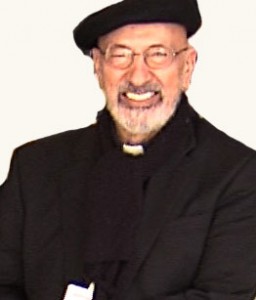
[powerpress]
Msgr. Esseff reflects on the major area that separates us from God…it’s sloth.  What is the truth about sloth? What does laziness really look like? To depend on oneself more than on God….”that I can do anything”, “I can do it”….the man of faith says “God can do it”.  Jesus said without the Father, he could do nothing.  That He does only what the Father tells him.  The solution to sloth is obedience…the obedience to the will of the Father.
Msgr. Esseff takes a strong look at King David and his actions after he becomes king…a leader who became consumed with himself.  Then he looks at a true leader…Jesus.  Msgr. has a strong message and challenge for families, our country, the world and our Church.
Msgr. John A. Esseff is a Roman Catholic priest in the Diocese of Scranton. He was ordained on May 30th 1953, by the late Bishop William J. Hafey, D.D. at St. Peter’s Cathedral in Scranton, PA. Msgr. Esseff served a retreat director and confessor to Blessed Mother Teresa.   He continues to offer direction and retreats for the sisters of the missionaries of charity around the world. Msgr. Esseff encountered St.  Padre Pio,  who would become a spiritual father to him. He has lived in areas around the world,  serving  in the Pontifical missions, a Catholic organization established by Bl. Pope John Paul II to bring the Good News to the world especially to the poor. Msgr. Esseff assisted the founders of the Institute for Priestly Formation and continues to serve as a spiritual director for the Institute. He continues to  serve as a retreat leader and director to bishops, priests and sisters and seminarians and other religious leaders around the world. Â
To obtain a copy of Msgr. Esseff’s book byvisiting here
Be sure to visit Msgr. Esseff’s website “Building a Kingdom of  Love”
Tags: catholic, catholic podcast, catholic prayer, cathollc spirituality, Good News, leadership, retreat, Roman Catholic, sloth, zeal
This entry was posted on Sunday, July 1st, 2012 at 9:23 am
You can follow any responses to this entry through the RSS 2.0 feed.
[powerpress = “Vatican_Radio”]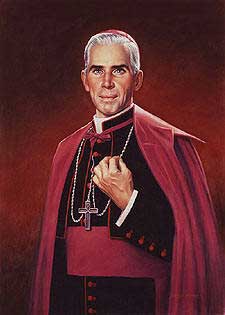
(Vatican Radio) Pope Benedict XVI on Thursday signed a decree recognizing the heroic virtue of the Servant of God, Archbishop Fulton John Sheen, allowing him to be styled as Venerable. This is the second major step in the process of his cause for canonization. Archbishop Sheen was ordained a priest of the Diocese of Peoria, Illinois, in 1919. He served the Church in Peoria for more than three decades, before being appointed auxiliary bishop of the Archdiocese of New York in 1951, and became the Bishop of Rochester, NY in 1966. During his years of service, he became the leading religious radio and television personality in the United States, while continuing to publish books and articles prolifically.
Bishop Daniel Jenky of Peoria told Vatican Radio the declaration gives US Catholics renewed confidence in a timely intercessor. “I believe [Ven. Fulton Sheen] is the perfect person to emulate in our current grave difficulties,†said Bishop Jenky, citing Sheen’s successful engagement with the culture at a time when National Socialism, the Great Depression, the Communist threat and growing moral challenges from many different quarters. “[Sheen] was not afraid to confront what was wrong,†Bishop Jenky said. “He would dialogue with the world,†he explained, “but – I also know – he had steel in him.â€
Tags: archishop fulton sheen, catholic, catholic podcast, catholic prayer, cathollc spirituality, new evangelization
This entry was posted on Saturday, June 30th, 2012 at 2:17 pm
You can follow any responses to this entry through the RSS 2.0 feed.
Published on Jun 23, 2012 by catholicpeter
This is the first part of two videos which show a selection of the great words and teachings of our Lord and Saviour Jesus Christ. I have only included a handful, probably the most well known. For every word that proceeded from His mouth was wonderful. The quotes are taken from the RSV-CE, RSV, and DRB Bibles. There are various images showing Christs life throughout.
Tags: catholic, catholic podcast, catholic prayer, cathollc spirituality, Lord Jesus Christ, Saviour Jesus Christ, sermon on mount, Visual Meditation
This entry was posted on Saturday, June 30th, 2012 at 1:39 pm
You can follow any responses to this entry through the RSS 2.0 feed.
Episode 18 Beginning to Pray:  “Heaven in Faith”  Day 9 Prayer 2- “God who is rich in mercy, impelled by His exceeding love, even when we were dead because of our sins, has brought us back to life in Christ Jesus.”
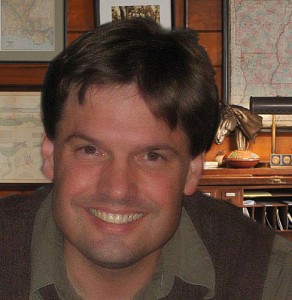
[powerpress]
Dr. Anthony Lilles is a Catholic husband and father of three teaching Spiritual Theology at St. John Vianney Theological Seminary. He  teaches spiritual theology and spiritual direction to transitional deacons, and the spiritual classics to the men who enter the Spirituality Year, a year of prayer in preparation for seminary formation.  He is the author of the “Beginning to Pray”  catholic blog spot.
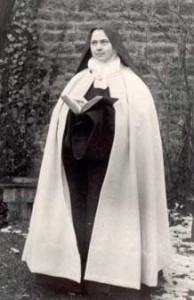 From “Heaven in Faith: Day 9 Prayer 2” found in The Complete Works vol 1:
From “Heaven in Faith: Day 9 Prayer 2” found in The Complete Works vol 1:
37.  “If anyone should affirm to me that to find the bottom of the abyss is to be immersed in humility, I would not contradict him.  However, it seems to me that to be plunged into humility is to be plunged into God, for God is the bottom of the  abyss.  This is why humility, like charity, is always capable of increasing.”
For other episodes in the series visit the Discerning Hearts page for Dr. Anthony Lilles
We would like to offer heartfelt thanks to
Miriam Gutierrez for providing for us “the voice” of Blessed Elizabeth for this series
Tags: Anthony Lilles, blessed elizabeth of the trinity, carmelites, catholic, catholic podcast, catholic prayer, cathollc spirituality, heaven and faith, Spiritual Theology, St. John Vianney Theological Seminary
This entry was posted on Saturday, June 30th, 2012 at 11:05 am
You can follow any responses to this entry through the RSS 2.0 feed.
Join Bruce and I as we discuss with Mike Aquilina the powerful and at the same time, poignant witness of the Holy Roman 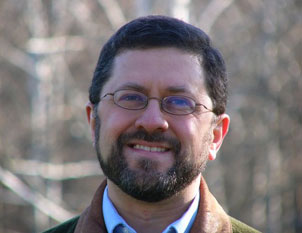 Martyrs[powerpress]
Martyrs[powerpress]
From Mike’s great website The Way of the Matyrs: ROMAN PROTOMARTYRS
Monday June 30th 2008, 10:23 am
Filed under: PatristicsToday’s the feast of the first Roman Martyrs. Theirs is a story you just have to hear. But first we have to backtrack a little bit.
In July of A.D. 64, during the tenth year of Nero’s reign, a great fire consumed much of the city of Rome. The fire raged out of control for seven days — and then it started again, mysteriously, a day later. Many in Rome knew that Nero had been eager to do some urban redevelopment. He had a plan that included an opulent golden palace for himself. The problem was that so many buildings were standing in his way — many of them teeming wooden tenements housing Rome’s poor and working class.
The fire seemed too convenient for Nero’s purposes — and his delight in watching the blaze didn’t relieve anybody’s suspicions. If he didn’t exactly fiddle while Rome burned, he at least recited his poems. Nero needed a scapegoat, and an upstart religious cult, Jewish in origin and with foreign associations, served his purposes well. Nero, who was a perverse expert at human torment, had some of its members tortured till they were so mad they would confess to any crime. Once they had confessed, he had others arrested.
He must have known, however, that the charges would not hold up. So he condemned them not for arson, or treason, or conspiracy, but for “hatred of humanity.â€
To amuse the people, he arranged for their execution to be a spectacle, entertainment on a grand scale. The Roman historian Tacitus (who had contempt for the religion, but greater contempt for Nero) describes in gruesome detail the tortures that took place amid a party in Nero’s gardens.
Mockery of every sort was added to their deaths. Covered with the skins of beasts, they were torn by dogs and perished, or were nailed to crosses, or were doomed to the flames. These served to illuminate the night when daylight failed. Nero had thrown open the gardens for the spectacle, and was exhibiting a show in the circus, while he mingled with the people in the dress of a charioteer or drove about in a chariot. Hence, even for criminals who deserved extreme and exemplary punishment there arose a feeling of compassion; for it was not, as it seemed, for the public good, but to glut one man’s cruelty, that they were being punished.
That is all we know about the first Roman martyrs. We know none of their names. Tacitus doesn’t tell us why they were willing to die this way rather than renounce their faith. Yet this should be an important question for us to consider. Why did the martyrs do this? What prepared them to face death so bravely? To what exactly did they bear witness with their death?
The answers to these questions (and many more) can be found in the rest of the article, at the archive of Touchstone Magazine. The article originated in a talk I gave in Rome in 2005 on the feast of the Roman Martyrs. It’s called “The Roman Martyrs and Their Mass.â€
I also treat the subject in my book The Resilient Church: The Glory, the Shame, & the Hope for Tomorrow.
Tags: catholic, catholic podcast, catholic prayer, cathollc spirituality, Holy Roman Martyrs, martyrdom, martyrs, mike aquilina, Roman Martyrs, rome
This entry was posted on Saturday, June 30th, 2012 at 10:47 am
You can follow any responses to this entry through the RSS 2.0 feed.
“For Greater Glory: The True Story of  Cristiada The Cristero War and Mexico’s Struggle for Religious 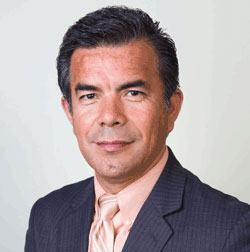 Freedom” is meant as a companion book to the film of the same name, but it truly be considered a stand alone in its own right.  Ruben Quezada does a fine job of outlining a horrific persecution which occurred just south of our border a little over 80 years ago, yet many of us know little or nothing about.  The Mexican government brutally killed men, women and children in an attempt to snuff out the life of the Roman Catholic Church in Mexico in the 1920’s.  Bishops and priests were martyred, Churches descrated, along many other atrocities. “Vivo Christo Rey” became the prayer triumphantly proclaimed by the Church Militant…this the story of their fight for religious freedom
Freedom” is meant as a companion book to the film of the same name, but it truly be considered a stand alone in its own right.  Ruben Quezada does a fine job of outlining a horrific persecution which occurred just south of our border a little over 80 years ago, yet many of us know little or nothing about.  The Mexican government brutally killed men, women and children in an attempt to snuff out the life of the Roman Catholic Church in Mexico in the 1920’s.  Bishops and priests were martyred, Churches descrated, along many other atrocities. “Vivo Christo Rey” became the prayer triumphantly proclaimed by the Church Militant…this the story of their fight for religious freedom
[powerpress]
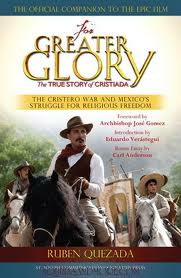 You can find the book here
You can find the book here
“For Greater Glory is a top-flight production whose message of the importance of religious freedom has particular resonance for us today.â€
— Most Reverend José Gomez, Archbishop of Los Angeles
“For Greater Glory is ‘must-see’ viewing for all those who care about faith and liberty today.â€
— Carl Anderson, Supreme Knight, Knights of Columbus
As you read you’ll discover:
• Who were the Cristeros?
• What drove the Mexican government to ruthlessly persecute Catholics?
• Can a priest “wage warâ€
• What role did groups like the Knights of Columbus play in this armed resistance?
• Why did thousands of Catholics – priests, religious, lay people – willingly give their lives in the Cristiada?
• What role did the U.S. play in ending this bitter conflict?
• What did the Pope do to support the Church in Mexico?
• Which characters in the movie went on to become Catholic saints and blesseds in real life?
• Why is this dramatic episode of history so little known today?
• What is the lesson of the Cristiada for those struggling for religious freedom today?
Tags: catholic, catholic podcast, catholic prayer, cathollc spirituality, cristero wars, freedom, igantius press, mexican martyrs, mexico, Ruben Quezada, Vivo Christo Rey
This entry was posted on Friday, June 29th, 2012 at 7:47 am
You can follow any responses to this entry through the RSS 2.0 feed.
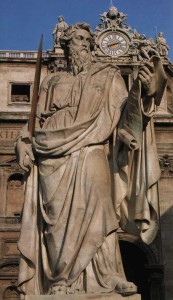
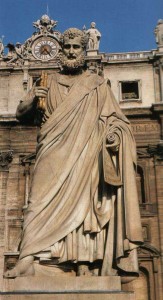 This is a FANTASTIC summation of the lives of Peter and Paul in the life of the early Church by Vatican Radio…don’t miss it!
This is a FANTASTIC summation of the lives of Peter and Paul in the life of the early Church by Vatican Radio…don’t miss it!
Why Peter and Paul ?
Wherever you go in Rome you always see Saint Peter and Saint Paul linked together.
Their feast day too is celebrated on the same day . Shouldn’t they each have their own feast day?
The irony is that they fought mightily in their lifetime and not just about trivial things but about matters that went to the very heart of what Christianity is all about.
Listen to Scripture scholar Mark Benedict Coleridge , Archbishop of Canberra and
Goulburn:[powerpress = “Vatican-Radio”]
Tags: acts of the apostles, apostles, catholic, catholic podcast, catholic prayer, cathollc spirituality, early church, martyr, martyrdom, Peter and Paul, Saint Peter, st peter, st. paul, sts. peter and paul, vatican radio
This entry was posted on Friday, June 29th, 2012 at 5:57 am
You can follow any responses to this entry through the RSS 2.0 feed.
“Flesh and blood has not revealed this to you, but my Father who is in heaven”
[powerpress=”daily-scripture”]
an excerpt from today’s reflection by Don Schwager:
Today in many churches of the East and West the Apostles Peter and Paul are commemorated. Both were martyred in Rome in the first century. They tirelessly worked for the spread of the gospel, not only to the people of Israel, but to all the nations as well. They risked their lives in the process and gladly poured out their blood in loyalty to their Master, the Lord Jesus Christ. As Paul so eloquently stated in his second epistle to Timothy, they courageously fought the good fight, finished the race, and kept the faith (2 Timothy 4:7).
How firm is your faith in the Lord Jesus Christ? At an opportune time Jesus tested his disciples with a crucial question: Who do men say that I am and who do you say that I am? (Matthew 16:13). Jesus was widely recognized in Israel as a mighty man of God, even being compared with the greatest of the prophets, John the Baptist, Elijah, and Jeremiah. Peter, always quick to respond, exclaimed that Jesus was the Christ, the Son of the living God. No mortal being could have revealed this to Peter; but only God. Jesus then confered on Peter authority to govern the church that Jesus would build, a church that no powers could overcome. Jesus played on Peter’s name which is the same word for “rock” in both Aramaic and Greek. To call someone a “rock” is one of the greatest of compliments. The ancient rabbis had a saying that when God saw Abraham, he exclaimed: “I have discovered a rock to found the world upon.” Through Abraham God established a nation for himself. Through faith Peter grasped who Jesus truly was. He was the first apostle to recognize Jesus as the Anointed One (Messiah and Christ) and the only begotten Son of God.
The New Testament describes the church, the people of God, as a spiritual house or temple with each member joined together as living stones (see 1 Peter 2:5). Faith in Jesus Christ makes us into rocks or spiritual stones. The Lord Jesus tests each of us personally with the same question: Who do you say that I am?
“Lord Jesus, I profess and believe that you are the Christ, the Son of the living God. You are my Lord and my Savior who has set me free from sin and deception. Make my faith strong like the Apostles Peter and Paul and give me boldness to speak of you to others that they may come to know you as Lord and Savior.”
for the full reflection visit : Daily Reading and Meditation
Tags: catholic, catholic podcast, catholic prayer, cathollc spirituality, don schwager, gospel of matthew
This entry was posted on Friday, June 29th, 2012 at 12:02 am
You can follow any responses to this entry through the RSS 2.0 feed.
USCCA15- Episode 15 – Baptism: Becoming a Christian
[powerpress]
Archbishop Lucas offers insights on the US Catholic Catechism for Adults Chapter 15:
As mentioned earlier in this chapter, the Lord himself affirms that Baptism is necessary for salvation.  “No one can enter the Kingdom of God without being born of water and the Spirit” (Jn 3:5).  Christ commanded his disciples to preach the Gospel, draw people to faith in him, and baptize those who come to conversion.  The Church does not neglect the mission she has received form Christ to ensure that all be baptized and reborn of water and the Spirit.
The Most Reverend George J. Lucas leads the Archdiocese of Omaha. Â
For other episodes in the visit our Archbishop George Lucas page
This programs is based on:
More information can be found here.
We wish to thank the USCCB for the permissions granted for use of  relevant material used in this series.
Also we wish to thank Deacon Chuck Adams  for his vocal talents in this episode.
Tags: Archbishop Lucas, baptism, baptisms, catholic, catholic podcast, catholic prayer, cathollc spirituality, George Lucas, united states catechism for adults
This entry was posted on Monday, June 25th, 2012 at 11:23 am
You can follow any responses to this entry through the RSS 2.0 feed.
I have read many fine Catholic Apologetic books over the years, but I have to say “How to Defend the Faith Without Raising  Your Voice: Civil Responses to Catholic Hot Button Issues” is the BEST!  Dr. Austen Ivereigh, along with the Our Sunday Visitor Editor in Chief John Norton, have compiled the “must have” text for any and all Catholics who desire to respond to the call for the New Evangelization.  More than answers to just about any issue  that could come forward in a discussion about the Catholic Church and the faith we profess, their work encourages  us to respond with reason based on the fundamentals of Catholic Social Teaching and decorum befitting virtue driven discourse.  Once again, this is a MUST HAVE.  Check out Austen’s article in the OSV weekly entitled “How to Defend the Faith“ for just a taste of what can be found in the book.
Your Voice: Civil Responses to Catholic Hot Button Issues” is the BEST!  Dr. Austen Ivereigh, along with the Our Sunday Visitor Editor in Chief John Norton, have compiled the “must have” text for any and all Catholics who desire to respond to the call for the New Evangelization.  More than answers to just about any issue  that could come forward in a discussion about the Catholic Church and the faith we profess, their work encourages  us to respond with reason based on the fundamentals of Catholic Social Teaching and decorum befitting virtue driven discourse.  Once again, this is a MUST HAVE.  Check out Austen’s article in the OSV weekly entitled “How to Defend the Faith“ for just a taste of what can be found in the book.
[powerpress]
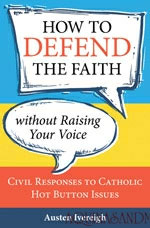 You can find the book here
You can find the book here
From the book description (and it’s 100% accurate):
It is about winning friends, not arguments. It is about shedding light, not heat. It’s about reframing the argument so hearts can be opened and minds can be inspired.Â
How to Defend the Faith without Raising Your Voice is a new sort of apologetics. It is for those moments when you are thrust into the spotlight as the token Catholic whether the spotlight is simply at the office water cooler or whether it is front and center at the in-laws Thanksgiving celebration. How to Defend the Faith without Raising Your Voice gives Catholics a fresh way of explaining the Church’s teaching on contentious issues humanly, compellingly, and succinctly.
But this book does not pretend to suggest it is as simple as memorizing a speech. Every conversation is different. Every day’s news cycle will bring new arguments and new challenges. Instead, it is a book about what the issues really are and where the criticisms are coming from so you can understand and communicate effectively.Â
It is the fruit of a group of speakers and experts brought together by a single idea: to make sure that Catholics and the Church were represented properly in the media when Pope Benedict came to visit the UK in 2010. Their original and thoughtful approach helped make that visit a triumph and now it can be expanded for a much broader use.
Whether read in groups or alone, studied in schools or parishes, How to Defend the Faith without Raising Your Voice offers the same thorough briefings on hot topics and the same top tips for effective communication which helped make the project such a success.
Tags: catholic, catholic podcast, catholic prayer, cathollc spirituality
This entry was posted on Monday, June 25th, 2012 at 9:19 am
You can follow any responses to this entry through the RSS 2.0 feed.
Show 9 ” Building a Kingdom of Love” – True Happiness and Joy

[powerpress]
Msgr. Esseff reflects on the true meanings of happiness and joy.  What does it really look like?  How can we live a life of happiness and joy?  Msgr. Esseff discusses the beatitudes and forgiveness and the keys to a proper understanding.  What is true humility?  How much the Father loves you!
Msgr. John A. Esseff is a Roman Catholic priest in the Diocese of Scranton. He was ordained on May 30th 1953, by the late Bishop William J. Hafey, D.D. at St. Peter’s Cathedral in Scranton, PA. Msgr. Esseff served a retreat director and confessor to Blessed Mother Teresa.   He continues to offer direction and retreats for the sisters of the missionaries of charity around the world. Msgr. Esseff encountered St.  Padre Pio,  who would become a spiritual father to him. He has lived in areas around the world,  serving  in the Pontifical missions, a Catholic organization established by Bl. Pope John Paul II to bring the Good News to the world especially to the poor. Msgr. Esseff assisted the founders of the Institute for Priestly Formation and continues to serve as a spiritual director for the Institute. He continues to  serve as a retreat leader and director to bishops, priests and sisters and seminarians and other religious leaders around the world. Â
To obtain a copy of Msgr. Esseff’s book byvisiting here
Be sure to visit Msgr. Esseff’s website “Building a Kingdom of  Love”
Tags: beatitudes, blessed mother teresa, catholic, catholic podcast, catholic prayer, cathollc spirituality, confessor, forgiveness, Good News, happiness, joy, mercy, retreat
This entry was posted on Sunday, June 24th, 2012 at 9:14 am
You can follow any responses to this entry through the RSS 2.0 feed.
From the Vatican.va archives June 24, 2007:
Today, 24 June, the liturgy invites us to celebrate the Solemnity of the Birth of St John the Baptist, whose life was totally directed to Christ, as was that of Mary, Christ’s Mother.
John the Baptist was the forerunner, the “voice” sent to proclaim the Incarnate Word. Thus, commemorating his birth actually means celebrating Christ, the fulfilment of the promises of all the prophets, among whom the greatest was the Baptist, called to “prepare the way” for the Messiah (cf. Mt 11: 9-10).
All the Gospels introduce the narrative of Jesus’ public life with the account of his baptism by John in the River Jordan. St Luke frames the Baptist’s entrance on the scene in a solemn historical setting.
My book Jesus of Nazareth also begins with the Baptism of Jesus in the Jordan, an event which had enormous echoes in his day. People flocked from Jerusalem and every part of Judea to listen to John the Baptist and have themselves baptized in the river by him, confessing their sins (cf. Mk 1: 5).
The baptizing prophet became so famous that many asked themselves whether he was the Messiah. The Evangelist, however, specifically denied this: “I am not the Christ” (Jn 1: 20).Nevertheless, he was the first “witness” of Jesus, having received instructions from Heaven: “He on whom you see the Spirit descend and remain, this is he who baptizes with the Holy Spirit” (Jn 1: 33).
This happened precisely when Jesus, after receiving baptism, emerged from the water: John saw the Spirit descending upon him in the form of a dove. It was then that he “knew” the full reality of Jesus of Nazareth and began to make him “known to Israel” (Jn 1: 31), pointing him out as the Son of God and Redeemer of man: “Behold, the Lamb of God, who takes away the sin of the world!” (Jn 1: 29).As an authentic prophet, John bore witness to the truth without compromise. He denounced transgressions of God’s commandments, even when it was the powerful who were responsible for them. Thus, when he accused Herod and Herodias of adultery, he paid with his life, sealing with martyrdom his service to Christ who is Truth in person.
Let us invoke his intercession, together with that of Mary Most Holy, so that also in our day the Church will remain ever faithful to Christ and courageously witness to his truth and his love for all.
Tags: catholic, catholic podcast, catholic prayer, cathollc spirituality, john the baptist, pope benedict xvi
This entry was posted on Sunday, June 24th, 2012 at 7:23 am
You can follow any responses to this entry through the RSS 2.0 feed.
We love to hear the stories of the lives of the saints, especially those we are not familiar with! Â So we owe a big thank you to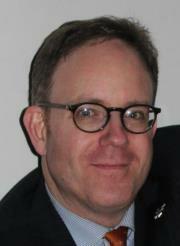
Brian O’Neel for shining the light on 39 holy unknowns in “Saint Who?”. Â Â Men and women, clerics, religious, and laity, married and single, there’s story from all walks of life. Â The book contains a short biography of each saint, a section on why that saint merits our attention and devotion today, and a short prayer. Â He also discusses with us what makes a blessed, what makes them a saint. Â A wonderful read.
[powerpress]
You can find the book here
Thousands of saints are formally recognized by the Catholic Church. While some are household names, have you heard of:
- St. Bathilde, the slave queen?
- St. Pietro Parenzo, the heavenly politician?
- Bl. Sebastian de Aparicio, the first cowboy?
- St. Mary Helen MacKillop, the excommunicated saint?
From these now-obscure saints or blesseds come amazing stories of virtue, vice, and the triumph of grace. Brian O’Neel tells these tales, often colorful and always compelling, with humor tempered by an obvious love for his subjects, explaining why they deserve our attention and devotion.
Tags: catholic, catholic podcast, catholic prayer, cathollc spirituality, saints
This entry was posted on Saturday, June 23rd, 2012 at 6:23 am
You can follow any responses to this entry through the RSS 2.0 feed.

